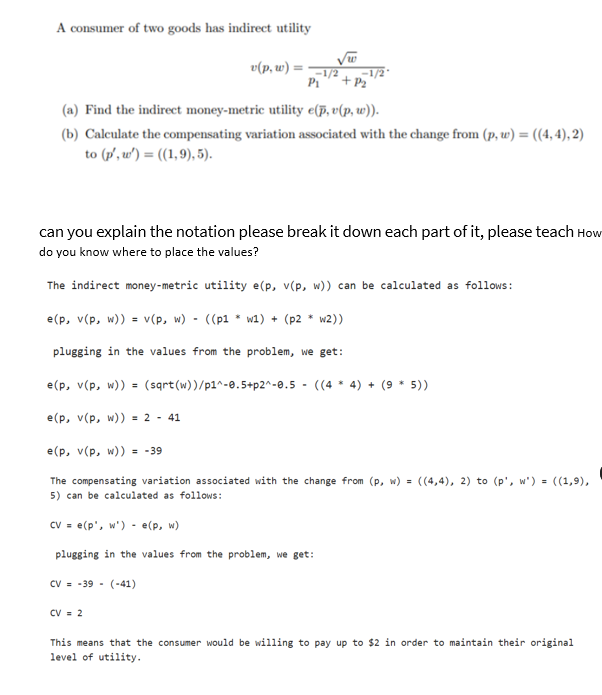A consumer of two goods has indirect utility v(p, w) = -1/2 P₁ + P₂ (a) Find the indirect money-metric utility e(p, v(p, w)). (b) Calculate the compensating variation associated with the change from (p, w) = ((4,4), 2) to (p', w')= ((1,9), 5).
A consumer of two goods has indirect utility v(p, w) = -1/2 P₁ + P₂ (a) Find the indirect money-metric utility e(p, v(p, w)). (b) Calculate the compensating variation associated with the change from (p, w) = ((4,4), 2) to (p', w')= ((1,9), 5).
Economics (MindTap Course List)
13th Edition
ISBN:9781337617383
Author:Roger A. Arnold
Publisher:Roger A. Arnold
Chapter20: Consumer Choice: Maximizing Utility And Behavioral Economics
Section20.1: Utility Theory
Problem 2ST
Related questions
Question
how to know what are what is p1, w1, which how to map the values

Transcribed Image Text:A consum
sumer of two goods has indirect utility
v(p, w) =
√w
-1/2
P₁ + P₂
(a) Find the indirect money-metric utility e(p, v(p, w)).
(b) Calculate the compensating variation associated with the change from (p, w) = ((4,4), 2)
to (p', w')= ((1,9), 5).
can you explain the notation please break it down each part of it, please teach How
do you know where to place the values?
The indirect money-metric utility e(p, v(p, w)) can be calculated as follows:
e(p, v(p, w)) = v(p, w) - ((p1* w1) + (p2 * w2))
plugging in the values from the problem, we get:
e(p, v(p, w)) = (sqrt(w))/p1^-0.5+p2^-0.5- ((44) + (9 * 5))
e(p, v(p, w)) = 2 - 41
CV = 2
e(p, v(p, w)) = -39
The compensating variation associated with the change from (p, w) = ((4,4), 2) to (p', w')= ((1,9),
5) can be calculated as follows:
CV = e(p', w')- e(p, w)
plugging in the values from the problem, we get:
CV-39 (-41)
This means that the consu would be willing to pay up to $2 in order to maintain their original
level of utility.
Expert Solution
This question has been solved!
Explore an expertly crafted, step-by-step solution for a thorough understanding of key concepts.
Step by step
Solved in 3 steps with 2 images

Knowledge Booster
Learn more about
Need a deep-dive on the concept behind this application? Look no further. Learn more about this topic, economics and related others by exploring similar questions and additional content below.Recommended textbooks for you

Economics (MindTap Course List)
Economics
ISBN:
9781337617383
Author:
Roger A. Arnold
Publisher:
Cengage Learning


Economics (MindTap Course List)
Economics
ISBN:
9781337617383
Author:
Roger A. Arnold
Publisher:
Cengage Learning
